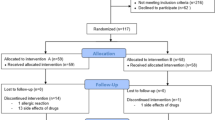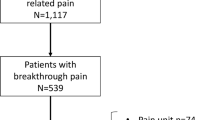Abstract
Prescribing practices for patients with cancer pain among populations of doctors in the United Kingdom have been assessed by means of a postal questionnaire. The results indicate that amongst the sample of doctors completing the questionnaire the basic principles of pain control in cancer appear to be understood. Regular oral morphine or diamorphine are most often chosen with the dose being determined mainly by the severity of pain with no arbitrary upper limit. Fears of addiction and respiratory depression, and a relatively long prognosis no longer appear to be major deterrents to the use of strong opioid analgesics. These data indicate considerable shifts in opinion in the doctors responding to the questionnaire and these results and their implications for current and future teaching about the management of cancer pain are discussed.
This is a preview of subscription content, access via your institution
Access options
Subscribe to this journal
Receive 24 print issues and online access
$259.00 per year
only $10.79 per issue
Buy this article
- Purchase on Springer Link
- Instant access to full article PDF
Prices may be subject to local taxes which are calculated during checkout
Similar content being viewed by others
Author information
Authors and Affiliations
Rights and permissions
About this article
Cite this article
White, I., Hoskin, P., Hanks, G. et al. Analgesics in cancer pain: current practice and beliefs. Br J Cancer 63, 271–274 (1991). https://doi.org/10.1038/bjc.1991.63
Issue Date:
DOI: https://doi.org/10.1038/bjc.1991.63
This article is cited by
-
Morphinofobia: the situation among the general population and health care professionals in North-Eastern Portugal
BMC Palliative Care (2010)
-
Opiophobie: état des lieux auprès des soignants à Beira Interior au Portugal
Douleur et Analgésie (2009)
-
Attitudes of Swiss physicians in prescribing opiates for cancer pain
Supportive Care in Cancer (1993)



